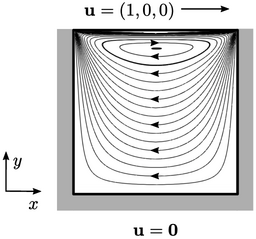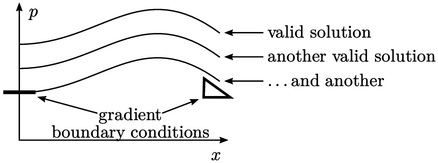4.4 Wall boundaries
The no-slip
condition is generally applied at a solid wall which is impermeable
(assuming  ). The condition is
). The condition is  , where
, where
 is
the velocity of the wall, which is usually stationary with
is
the velocity of the wall, which is usually stationary with
 .
The proof behind the no-slip condition is that it predicts a
pressure drop along tubes of small diameter which matches
experiments.3
.
The proof behind the no-slip condition is that it predicts a
pressure drop along tubes of small diameter which matches
experiments.3

The 2D, lid-driven cavity is a flow problem in which no-slip conditions
are applied at all boundaries. It provides insight into the
boundary condition for  at a wall. From Eq. (2.47
) for an
incompressible fluid, with
at a wall. From Eq. (2.47
) for an
incompressible fluid, with  constant, the component normal to the
domain boundary is
constant, the component normal to the
domain boundary is
 |
(4.4) |
 , reducing the gradient condition to
, reducing the gradient condition to
 |
(4.5) |
 constant)
constant)  , so is only non-zero where there is flow normal
to the boundary in its vicinity, e.g. at the corners of the cavity in
our example. The term is usually small and its calculation involves
extrapolation from the internal solution which often causes
instability, so it is generally ignored.
, so is only non-zero where there is flow normal
to the boundary in its vicinity, e.g. at the corners of the cavity in
our example. The term is usually small and its calculation involves
extrapolation from the internal solution which often causes
instability, so it is generally ignored.
A body force  , e.g. gravity, is generally prescribed
so it does not introduce instability. Where it is significant, it
must be included in the boundary condition, i.e.
, e.g. gravity, is generally prescribed
so it does not introduce instability. Where it is significant, it
must be included in the boundary condition, i.e.  .
.
Otherwise, in the absence of a body force, we
reach the standard form of boundary condition for pressure at a
wall,  .
.
Fixing pressure
With only fixed gradient conditions on pressure at the boundary, the pressure value is not fixed at any point in solution domain. The solution is not unique, as shown in the 1D example below with gradient conditions at both ends.

To achieve a unique solution,  must then be fixed
to a reference value
must then be fixed
to a reference value  at a reference cell
at a reference cell  in the domain. To
achieve this, the diagonal coefficient
in the domain. To
achieve this, the diagonal coefficient  is doubled and
is doubled and
 is
added to source
is
added to source  , in the matrix equation
, in the matrix equation  described by
Eq. (3.1
). This minimal change
“pins” the solution to
described by
Eq. (3.1
). This minimal change
“pins” the solution to  in cell
in cell  .
.

